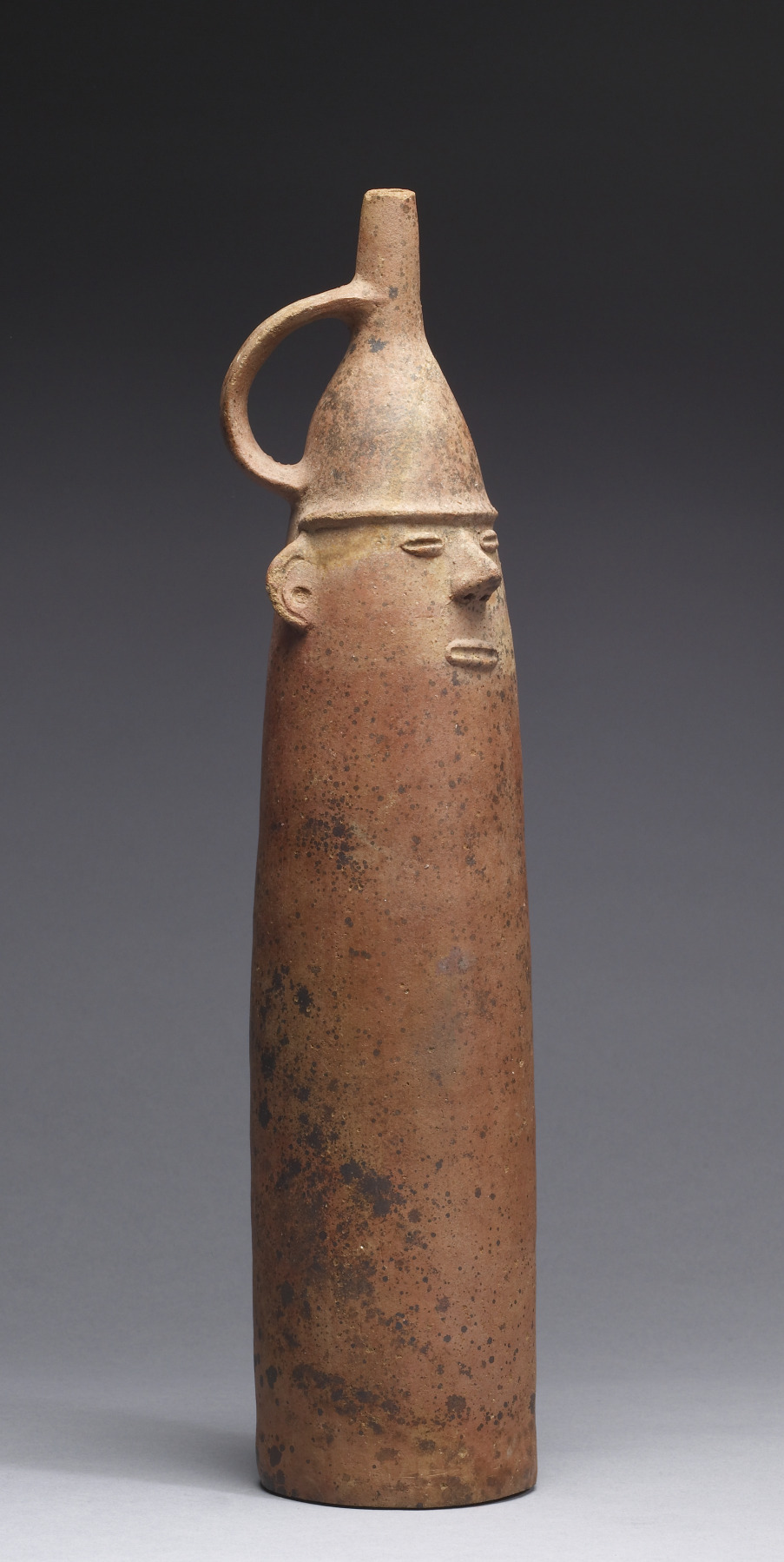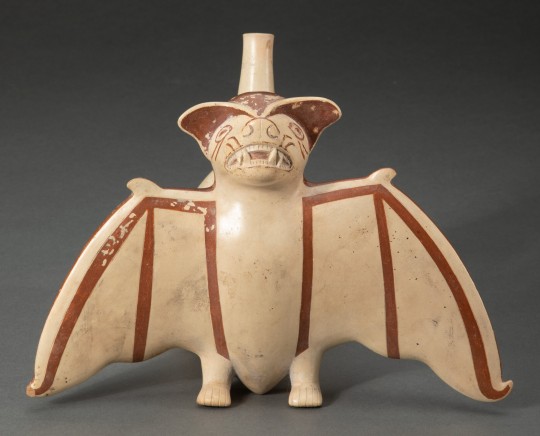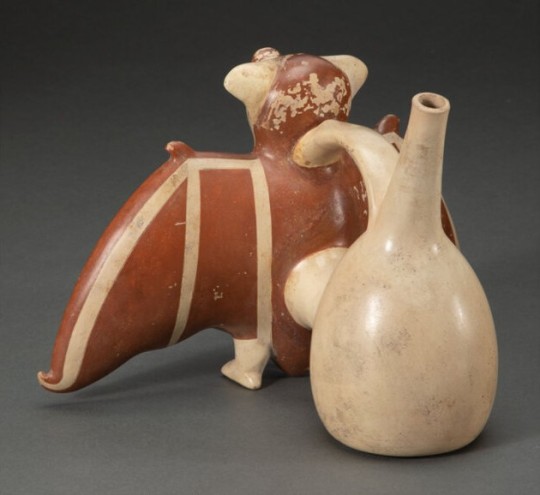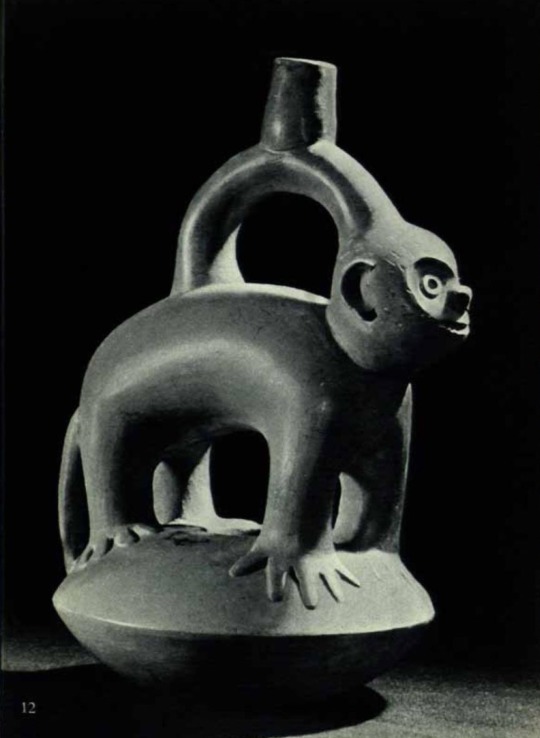#Salinar
Explore tagged Tumblr posts
Text
More bling from Peru for #SaveASpiderDay: golden spiders for your face!
Spiders can be found in Andean iconography going back at least 2500 years as symbols of warfare, ritual sacrifice, and agricultural fertility. Here are three examples found on facial jewelry, from The Met's collection:

1. Nose ornament, 100 BCE - 200 CE, Peru, North Coast, Salinar culture; gold, H. 2 x W. 4 3/8 x D. 1/8 in. (5.1 x 11.1 x 0.3 cm)

2. Nose ornament, 6th–7th century CE, Peru, Moche; gold, silver, shell, H. 2 5/8 x W. 3 3/8 x D. 1/4 in. (6.7 x 8.6 x 0.6 cm)

3. Earflare frontal, Spider, 6th–7th century CE, Peru, Moche; gold, silver, H. 3 1/2 × W. 3 1/2 × D. 3/4 in. (8.9 × 8.9 × 1.9 cm)
#PleaseNoSquish 🕷️
#spider#arachnids#invertebrates#jewelry#jewellry#facial jewelry#nose ornament#ear flare#Peruvian art#South American art#Indigenous art#ancient art#pre-conquest art#Salinar#Moche#metalwork#decorative arts#iconography#Metropolitan Museum of Art New York#Save a Spider Day#Please No Squish#animals in art
50 notes
·
View notes
Text

Single Spout Vessel with Bird Attached to Strap Handle
Salinar
200 BCE–200 CE
source
0 notes
Photo

Figurative Bottle from peru
Salinar 200 BC-AD 100
(Early Horizon-Early Intermediate) Earthenware
The Walters art museum
180 notes
·
View notes
Text



A Dramatic Salinar Bat Effigy Vessel Peru, Early Horizon - Early Intermediate Period, circa 200 BC - 100 AD
183 notes
·
View notes
Text

Stone macehead, Salinar culture, northwest coast of Peru, 2nd century BC - 1st century AD
from The Cleveland Museum of Art
98 notes
·
View notes
Text


This vessel is modeled in the shape of a spiral platform surmounted by an open-sided structure with a figure inside. The vessel itself is a bottle, with a spout in the shape of a stirrup, a characteristic shape on Peru’s north coast from the first millennium B.C. through the later part of the first millennium A.D. The spiral platform is ornamented with a procession of snails, sculpted in high relief, and felines, painted in red slip, ascending to the summit where a figure is depicted within a four-posted, roofed structure on a circular podium. The figure wears a conical headdress, ear ornaments, and a beaded collar, and holds a war club across his chest.
Finely made and delicately painted, this bottle would most likely have been used in Moche ceremonial contexts before its ultimate deposition in a burial. The Moche culture flourished on Peru’s north coast from A.D. 200 to 800. Powerful men, and sometimes women, ruled over regional centers in the fertile river valleys of this otherwise arid desert region. Moche sites were characterized by monumental pyramidal platform mounds made of mud brick, often ornamented with polychrome reliefs. Moche artists were renowned for their achievements in metallurgy as well as for their sophisticated ceramic traditions featuring ritual and mythological scenes.
Modeled and painted ceramic bottles were a favored form for Moche artists, as they were for their predecessors, the Salinar and the Gallinazo cultures. Of the thousands that have survived to the present day, several hundred feature architectural structures. Some emulate monumental platform mounds, occasionally with a figure at the summit, while others focus on a specific structure located within a larger complex. A number of Moche vessels depict spiral platforms, but actual spiral platforms are fairly rare in the archaeological record. A notable example of a monumental spiral platform was excavated at the site of Moche, on the plain between the two architectural complexes of Huaca del Sol and Huaca de la Luna.
Few architectural vessels have been excavated under controlled conditions, but of those that have, they have been found in both middle- and high-status burials of adult women, young males, adolescents, and children. Some have been found in burials close to ritual architecture, and the representations themselves often refer to processional ways and places of sacrifice. This effigy perhaps served as an emblem of the power and potential of the sacred architecture it emulated.
Joanne Pillsbury, 2015
https://www.metmuseum.org/art/collection/search/308415
14 notes
·
View notes
Text
Names derived from Tolkienesque forenames, theological angels, and superlatives, excluding the letter "E"
Abalth Ablaracalla Addacild Addalith Adradrata Adûna Agasin Agudir Aihir Ailúk Aindil Ainvannat Airdaiang Aladacir Alattant Algranákhôr Alimor Alindand Amild Amitë Amling Amragudil Amran Amranor Amron Amrothair Ancil Ancir Andil Andir Andis Andor Anduin Andust Anfainúmil Anfalm Angoldach Angor Animuzgal Animë Annar Antan Antar Anthorophon Aradardan Araglirman Arail Aramag Arand Aranduil Aranur Araphang Arashan Arasin Arassad Aravanwë Arazaphoron Arazôn Arcir Ardannas Ardar Ardil Ardilthôr Ardir Argos Arinwë Arinúmil Armaurvia Arthéod Artullik Atamalabar Athil Atillion Auglúk Azimair Azrandaind Azraphil Azrazôr...
Bador Baharfinar Balfan Bardaiahang Barombur Baron Bightarast Bithothim Blarikar Blarunna Blatar Blorn Blund Bofthôn Boldor Bombar Bomir Bormtor Boros Braca Brach Bragorl Brahráin Brast Brazil Brazran Brimbusil Brion Briën Bryar Bulkanwë Bëorl Bëorn Bëoron Bórwar Caldorlion Caldur Carah Caran Carma Catron Chaphil Charin Cilaugdur Cilimrardar Clorn Clowmaca Clurtz Coori Cothaphirë Cranamil Craphon Crinil Criën Curiën Curtil Dalin Dallos Dardancaróf Dorbarad Dorina Dorod Doron Drant Driah Duicir Dular Durionna Durust Dusilmon Déallinúvir Déomir Déoth Fainnardaia Faldant Fanarcir Fangolwë Fastirion Fatalma Filúk Findir Finzil Firyah Flain Fland Flant Folorn Forion Foron Frind Frindumo Fréago Fréagold Fréagon Fréagor Frórindómir Fëangon Fílimloth Fírdarost Gabadamar Gabar Gadrin Galadan Galast Galingrik Gallouglik Gamilkardin Gamrouglin Gamsirë Gasin Gildil Gildon Gilgancalca Gimbal Gimrah Glast Glindrat Glinin Gloolgalain Golionwë Gorfil Gortur Graph Grapharcir Grararth Grathor Griondran Grohilúk Grontata Grómil Hadaming Halcwin Haldil Haldë Halin Hamroddor Hamrondir Hamûl Hangoldum Hangor Hanwë Harata Hardair Hardal Hargormanth Haronwë Hassuirë Hingloon Horomë Hossir Huaqqibûn Hubbithon Humbrion Hunnarimë Huoldor Hushorië Hyath Hyavi Hámaminduin Ibaulë Ibûnah Idurl Ildarantho Imbrinar Imiryaviad Imoilir Indanch Indli Indorn Isildir Iskil Iskin Itchinc Jophor Juild Kirim Kusilgash Kílik Lalanthôr Lararë Latandor Limin Lithia Londandum Lossunír Lothon Loughâl Loungon Luilin Lumaiar Lurth Léotha Makil Malaca Malitho Mamanth Mandusil Manthoron Marat Mirmaras Mithramrons Muanassion Muladorthir Mulair Mulfin Mulfwin Mírdil Nahtar Nakar Naraiadil Naraphar Nauglas Ningrossion Nittârin Noisrah Nurvir Nólin Nómil Olcaldwyn Oldog Ollia Orlim Palas Palfwinros Paláf Phast Plador Polór Powyn Primanil Prondil Purlada Purviarun Rangoldir Ranor Ranthéod Razazach Razôr Rildon Rintor Riont Rondor Rophamin Ríand Sacali Sadomë Salar Salbah Salchub Saldal Saldorod Salik Salinar Salmil Salthôr Samlimog Sanim Sanáinbri Saughtil Sauglador Sauglitë Saugloth Sauglúk Saulast Saust Scalfin Sharfil Sharros Shmorlaihin Shnáin Shnáincil Shnákhîm Shnákhôn Shnárin Shoril Shossandir Siaron Simlin Singwin Skinindil Slimundor Slion Slorroador Smacir Smalast Smalmo Smancaláf Smandurucir Sméawin Sofur Soomë Soorfin Soorost Soron Souglon Súriandurië Tabaglor Taldil Tamracir Tamûl Tanbrapho Tanch Tanur Tarda Tardagon Tardir Tharavor Thardag Thargor Thing Thingran Thongwin Tiust Tuolwë Tuolór Turimron Turin Turind Tzagdur Tzazim Túrimir Túrisir Ufingun Ugassil Ulkhar Ulmaalthrór Ulwin Unkasil Uolóin Urondorod Urubifunkas Urunkan Uzgan Valadacir Valaurth Valdadûnan Valgas Valliahamli Vanin Vanwë Vathéod Vidufin Viduin Vincalik Vorman Vánamir Vánar Vánast Vánatalast Waindë Winca Winimë Worod Yáviah Zachalg Zadan Zadrór Zagoldog Zimbucargil Zophoroddoc Zophos Éodróg Éodwyn Éothar Éothiahadoc Éothor
4 notes
·
View notes
Text

“Stirrup spouted jar representing a monkey standing on a circular vessel, which is actually annular since it is formed around a central opening. Salinar Culture, Chicama Valley. Rafael Larco Hoyle Collection.”
From: “Ancient peoples places vol. 1 (Peru)” by Bushnell, G. H. S.; 1956.
17 notes
·
View notes
Text





Inktober 2022 was a fun ride for me, and I only now had a chance to start posting these. They were all a fun way for me to experiment with Dark Children project and explore some of the more recent concepts for it, as well as see if I can find one or two elements in it to draw for each challenge theme (and if not, then picked whatever came to mind first)
Day 1 - Gargoyle: Kalis the gargoyle
Day 2 - Scurry: Salinar snatching a piece of pie... instead of asking for a bite
Day 3 - Bat: Koraderian bat creature
Day 4 - Pearl: a fish person from the dimension of Moon, Muruka
Day 5 - Flame: Scratch and his fire
More coming later!
2 notes
·
View notes
Photo

Single Spout Vessel with Bird Attached to Strap Handle, Salinar, -200, Art Institute of Chicago: Arts of the Americas
African and Amerindian Art Purchase Fund Size: H. 19.1 cm (7 1/2 in.) Medium: Ceramic and pigment
https://www.artic.edu/artworks/12784/
15 notes
·
View notes
Text
Un contexto del Horizonte Medio en Huaca Santa Rosa de Pucalá
Un contexto del Horizonte Medio en Huaca Santa Rosa de Pucalá
La Tumba 21: Un contexto funerario del Horizonte Medio en Huaca Santa Rosa de Pucalá[1], Valle de Lambayeque EDGAR BRACAMONTE[2] RESUMEN Las investigaciones arqueológicas en Huaca Santa Rosa, localizada en el extremo final del valle bajo de Lambayeque, Costa Norte del Perú, permitieron conocer la existencia de un asentamiento cuyo poder y prestigio perduró por más de 2500 años. Así mismo, se…

View On WordPress
#arqueologia de lambayeque#Huaca Rajada#Huaca Santa Rosa de Pucalá#Naymlap#Pampagrande#salinar#Sipán#Vicús#viru
1 note
·
View note
Text
#FishFriday 🐟:



Stirrup-spout vessel: man on fish Salinar culture, Peru, 300–100 BCE Ceramic and slip 7 5/16 x 4 17/32 x 8 5/8 in. (18.6 x 11.5 x 21.9 cm) Dallas Museum of Art 1984.W.88
PS is it just me or does the fish's face look like the 😬 emoji LOL
#animals in art#fish#animal effigy vessel#Indigenous art#ancient art#Peruvian art#Andean art#South American art#Salinar art#animal effigy#effigy vessel#ceramics#pottery#Dallas Museum of Art#Fish Friday#humans riding animals
55 notes
·
View notes
Text

Parrot Head Bottle
Salinar (?)
1st century BCE–2nd century CE
source
0 notes
Photo

Architectural Vessel
200 B.C. – A.D. 200
Peru
Salinar
Ceramic
113 notes
·
View notes
Photo

Nose Ornament with Spiders, Date: 1st century B.C. – A.D. 2nd century, Geography: Peru, Culture: Salinar (?), Medium: Gold.
http://www.metmuseum.org/toah/works-of-art/1979.206.1172/
3 notes
·
View notes
Text
show up to work drinkin coffee out of this

0 notes